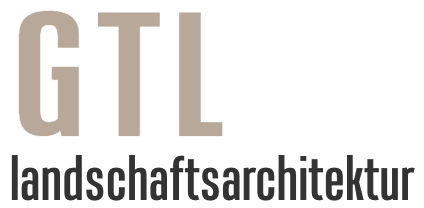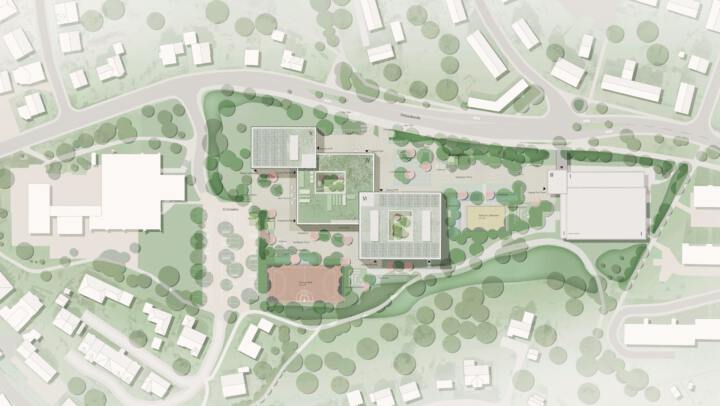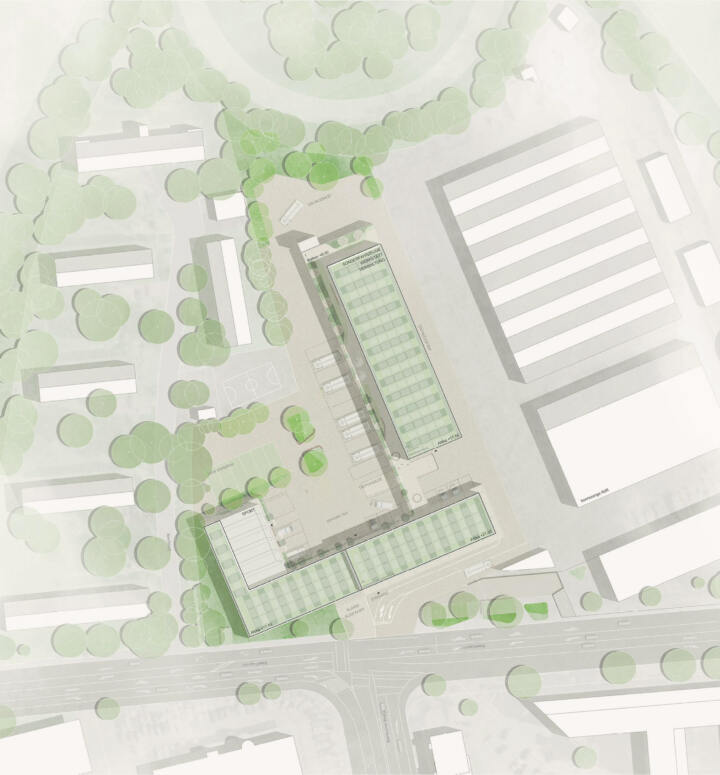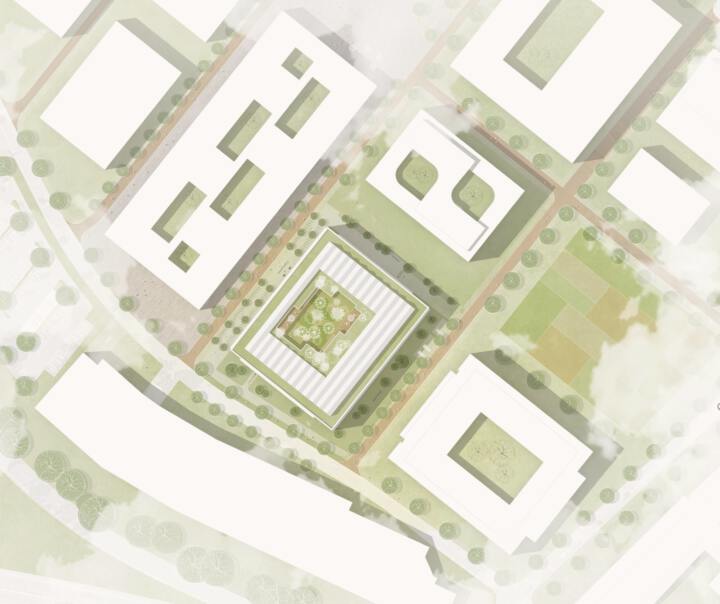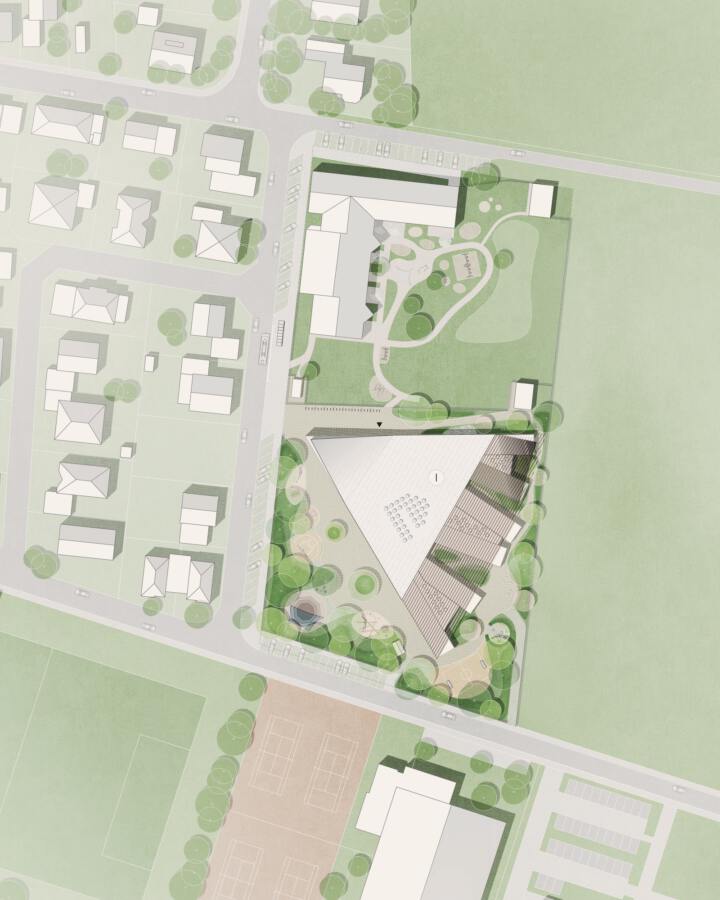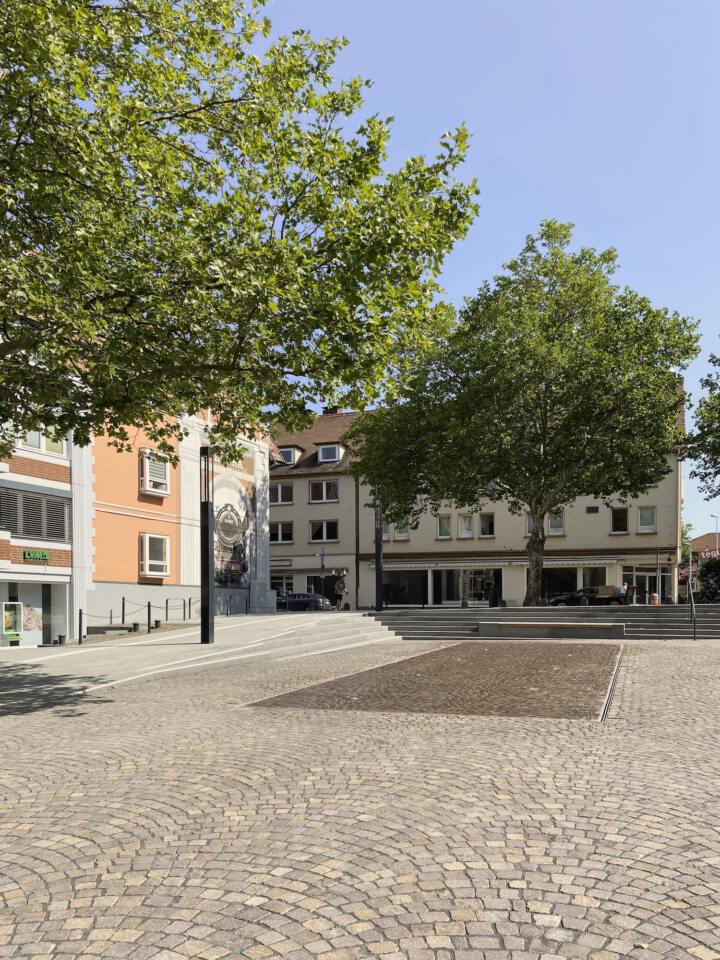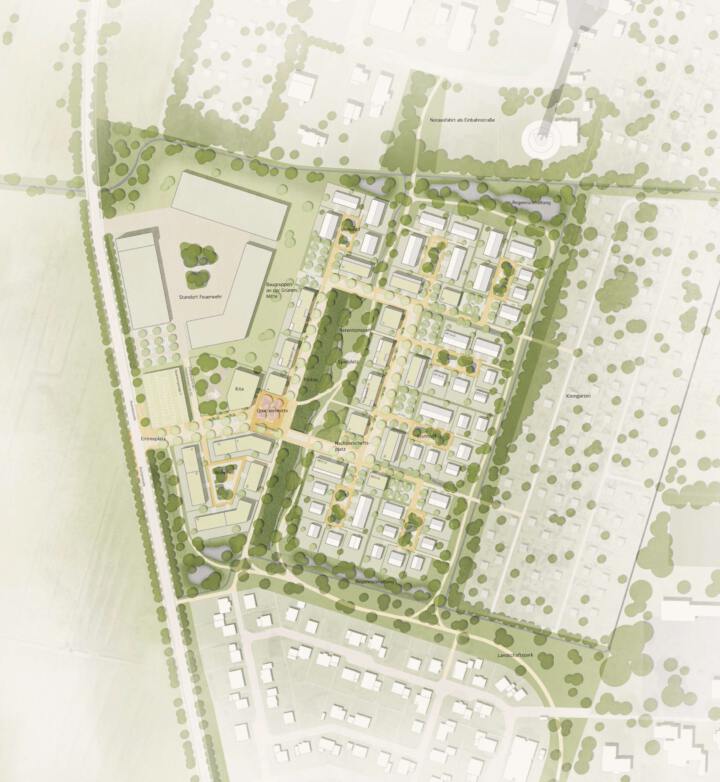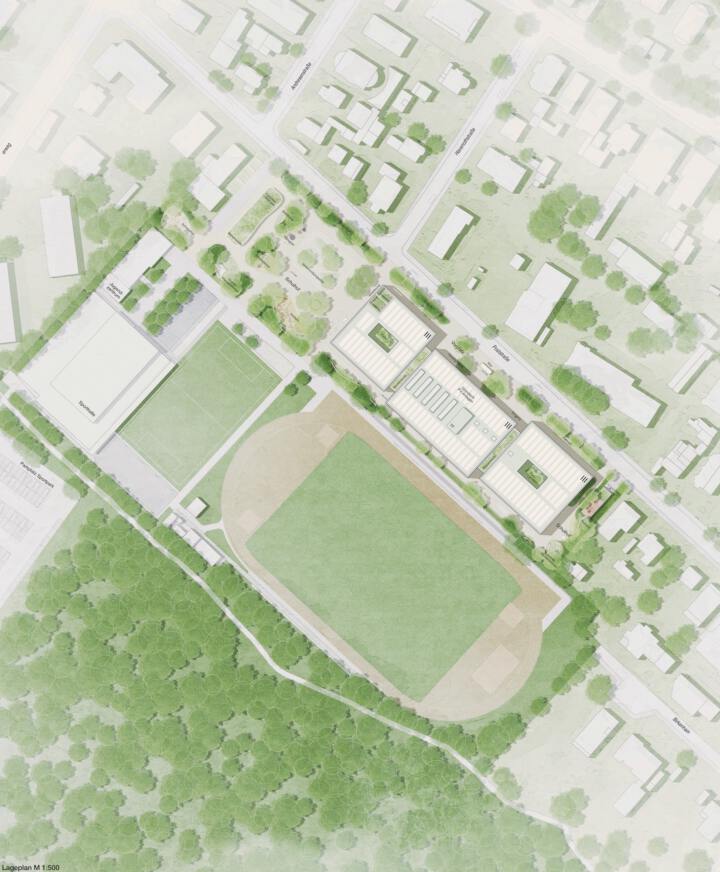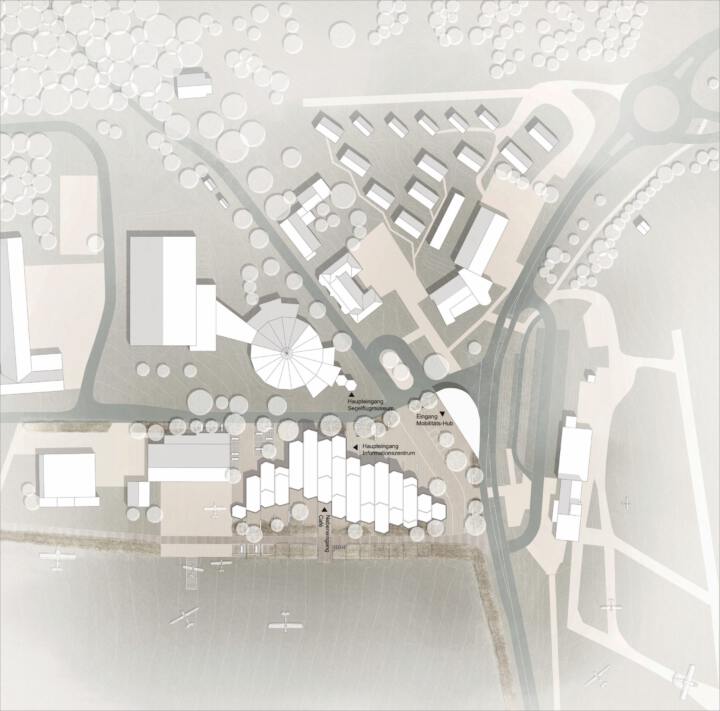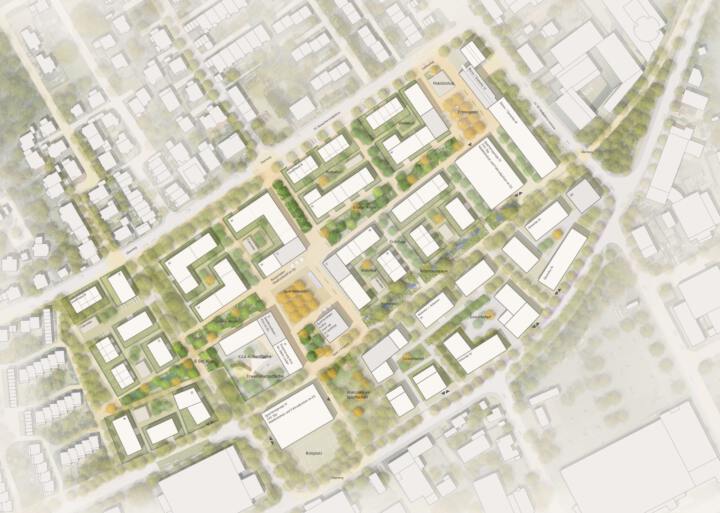04 | 2025 COMPETITION
Children's Centre, Educational Campus Rainbrunnen | Schorndorf
Recognition | In collaboration with Atelier 30
The new children's centre and the extension to the school building on the Schorndorf educational campus form a central area that harmonises with the outdoor facilities and creates generous open spaces. The entrance area, equipped with multi-trunked trees and a round bench, forms the prelude to the school and kindergarten grounds and serves as a passageway and recreation area. To the east, the open space in front of the dining hall expands and merges into the schoolyard with playing field. The building structure divides the outdoor areas into clearly defined zones. A western playground is bordered by a linear play sculpture with sand play, climbing and sliding facilities. The northern play yard is designed as an exercise yard with age-appropriate play equipment. In the north-eastern area is the school garden, which enables barrier-free gardening and outdoor lessons. The open space is designed as a heavily greened play and school landscape with large-crowned trees of the future and structured by sunken areas of grasses and shrubs. In addition to their insect-friendly abundance of flowers, these areas also serve as retention and seepage areas.
© Atelier30, GTL
05 | 2025 COMPETITION
Redesign of the Mühlenberg School Campus | Wipperfürth
Recognition | In collaboration with LH Architekten and STLH Architekten
The new school campus places great emphasis on the design and quality of open spaces. It is accessed from the north and south-west, with all required parking spaces having been reorganised. The two schoolyards are adapted to the respective topography and laid out on different levels – with covered areas created by building recesses. Green islands, tree plantings and light-coloured, glare-free surfaces improve the microclimate and create a high quality of stay. The shared sports fields and ‘green classrooms’ are located in the southern green belt, which has been designed to be close to nature and made visible by seating edges in the topography. Rainwater retention has been integrated into the terrain. The roof areas are intensively or extensively greened, partly used as retention roofs, partly as roof terraces for the schools. The overall result is a well-designed, ecologically valuable open space with a high degree of versatility and quality of stay.
© LH Architekten, STLH Architekten, GTL
06 | 2025 COMPETITION
New Fire and Rescue Station I | Bonn
2nd prize | In collaboration with Steimle Architekten
The outdoor facilities of the new fire station are functional in nature and largely occupied by parking areas and turning circles. The quality of the outdoor space is therefore mainly found on the first floor: a surrounding, green terrace band creates a green setting with seating areas, especially in the east above the vehicle hall. The uppermost roof areas are extensively greened in combination with photovoltaics as retention roofs – important for rainwater management, as the paved courtyard areas do not allow for infiltration. In the inner courtyard, a central green island with trees remains free of traffic, complemented by green facades on the west wing. Visitor and bicycle parking spaces are located on the remaining area near the shared access road with BonnOrange. Existing trees in the west will be largely preserved, and the green strip will be densified. Robust, climate-resilient trees and shrubs, as well as nutrient plants and nesting sites, will promote biodiversity.
© Steimle Architekten, GTL
06 | 2025 COMPETITION
New Molecular Biology Building at the University of Biology on the Poppelsdorf Campus of the Rheinische Friedrich-Wilhelms-Universität | Bonn
1st prize | In collaboration with Atelier30
The new laboratory building for molecular biology integrates diverse, high-quality open spaces into the campus environment. The area in front of the main entrance is landscaped and offers a pleasant place to linger, as well as integrated bicycle parking spaces. The centrepiece of the open space concept is the differently designed inner courtyard with a green centre and adjoining terraces, which is excitingly structured by offsets in the building's shape. It functions as a connecting element and a place for exchange. There are further terraces with a high amenity value on several levels. The roof areas are extensively greened with native grasses and shrubs to promote biodiversity. A large roof terrace is available as a place of relaxation for employees. Photovoltaic systems on the roof complement the overall sustainable concept. The open spaces not only support the microclimate, but also strengthen communication and identity on the campus.
© Atelier30
07 | 2025 COMPETITION
Extension and renovation of two primary schools | Sassenburg
1st prize | In collaboration with Kauffmann Theilig & Partner
The new open space concept for the school grounds picks up on the open structure with multiple access points and views of the landscape, developing it into a diverse, natural schoolyard. Dense, varied planting surrounds the triangular school building and creates sheltered, organically shaped recreational areas. The schoolyard is functionally divided into a western exercise area with a climbing sculpture, sports and play facilities, and a sound garden with a shaded outdoor classroom. To the east, a quiet retreat is being created with a green classroom, garden areas and niches for lingering. The furniture promotes communication and individual use. Plantings at the edges create privacy and support ecological learning processes. The design responds to climatic challenges and raises awareness of sustainability. Bicycle parking spaces are retained and functional access points, such as to the waste disposal area, are integrated.
© Kauffmann Theilig & Partner, GTL
08 | 2025 PROJECT
Town hall square | Bebra
Completion
The Bebra Town Hall Square shines in new splendour! With its completion, a modern, inviting square has been created that encourages people to linger, meet and celebrate. A spacious staircase with seating leads directly to the heart of the market square, where trees, benches and a traffic-free area create a relaxed atmosphere. Different floor coverings and reused paving stones combine tradition with modern design. The highlight is the new fountain area – a place to play and cool off in summer temperatures during the day, atmospherically lit in the evening.
Whether it's the weekly market, a city festival or simply a break in between: there's room for everyone here. The memorial plaques commemorating Jewish history have also found a worthy location here.
And it continues: the second construction phase has now started directly adjacent in Amalienstraße to ensure a uniform, attractive cityscape there as well.
12 | 2025 COMPETITION
Westerwischstrom Quarter | Cuxhaven
3rd prize | In collaboration with Thomas Schüler Architects and Urban Planners
The new neighbourhood develops a clear urban identity from its special island location: a central green space forms the green heart around which all building plots are grouped. This green centre connects the neighbourhood with the surrounding landscape and, with its paths, creates a lively fabric of neighbourhoods and public spaces.
As a retention green space, it also fulfils an important ecological function. Designed to be close to nature, it absorbs rainwater, promotes evaporation and strengthens local biodiversity. Garden courtyards, play and recreation areas, and climate-resilient planting make it a place for people to meet and relax.
A car-free living environment, decentralised mobility options and sustainable rainwater management based on the sponge city principle combine urban quality of life with ecological responsibility – making the neighbourhood a forward-looking model for communal, green living.
© Thomas Schüler Architekten und Stadtplaner, GTL
10 | 2025 COMPETITION
Replacement building for the GGS - Strand Europaschule | Timmendorfer Strand
A third prize | In collaboration with Baufrösche Architects and Urban Planners
The new GGS Strand Europaschule combines a primary school and a community school in a clearly structured wooden building that combines educational diversity, sustainability, and spatial flexibility. The compact design creates a spacious open area that serves as a shared schoolyard and a diverse meeting place.
The outdoor facilities form a coherent learning and exercise landscape: from the green entrance area to the sheltered primary school playground with play equipment and green classroom to the large playground with groups of trees, seating areas, and play zones, a lively outdoor space for learning, playing, and community is created. Rainwater management, extensive green roofs, and species-rich planting areas promote biodiversity and create a sustainable microclimate. This makes the school a place that harmonizes architecture, environment, and education.
© Baufrösche Architekten und Stadtplaner, GTL
10 | 2025 COMPETITION
Wasserkuppe Arrival & Information Centre | Gersfeld (Rhön)
3rd prize | In collaboration with Sturm und Wartzeck
Basalt is the leitmotif of the design for the new information centre on the Wasserkuppe in Gersfeld. Like the multi-layered formations of the Rhön, the building responds to its surroundings with offset structures and differentiated edges. It connects the heterogeneous existing buildings with the open airfield and creates a central square in the northeast as the new centre of the area. To the south, the building opens up to the vastness of the landscape with terraces and viewing platforms.
The outdoor facilities also take up the basalt motif: staggered terraces follow the natural terrain and become spaces that can be experienced via steps and benches. Materials such as basalt, wood and golden accents create a harmonious unity of architecture and landscape. In the north, lush planting frames the event area, while in the south, an open green strip forms the transition to the gliding field.
© Sturm und Wartzeck, GTL
09 | 2025 COMPETITION
Former Telecommunications Office | Heusenstamm
1st prize | In collaboration with Thomas Schüler Architekten und Stadtplaner
The new urban quarter in Heusenstamm combines living with working and creates a sustainable environment with a high quality of open space. The central element is the Grüne Anger, a corridor with play, recreation and fitness areas under climate-resilient trees, supplemented by troughs for rainwater retention and biodiversity promotion. Green joints structure the building plots and facilitate orientation. The heart of the district is the neighbourhood square with fountains, play and event areas, framed by neighbourhood and multi-generational houses and a daycare centre, complemented by an entrance plaza with restaurants and neighbourhood amenities. Mobility is reorganised through neighbourhood garages and a mobility station with car sharing, rental bikes and e-charging stations, so that the inner area remains largely traffic-free. A three-stage rainwater concept and extensive greening strengthen climate resilience and the microclimate.
© Thomas Schüler Architekten und Stadtplaner, GTL

